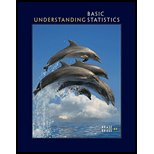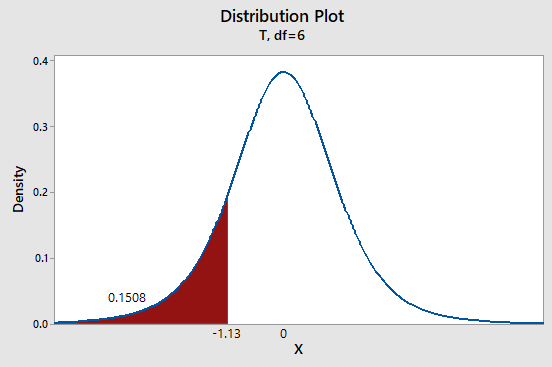
Concept explainers
The verification of
Explanation of Solution
To find the required statistics using the Minitab, follow the below instructions:
Step 1: Go to the Minitab software.
Step 2: Go to Stat > Basic statistics > Display
Step 3: Select dataset ‘Field A’ and dataset ‘Field B’ in variables.
Step 4: Click on OK.
The obtained output is:
Statistics
| Variable | N | N* | Mean | SE Mean | StDev | Minimum | Q1 | Median | Q3 | Maximum |
| Sample 1 | 7 | 0 | 4.000 | 0.900 | 2.380 | 2.000 | 2.000 | 3.000 | 6.000 | 8.000 |
| Sample 2 | 8 | 0 | 5.500 | 0.982 | 2.777 | 2.000 | 3.000 | 5.500 | 7.750 | 10.000 |
From the above output we have find that the values of
(a)
(i)
The level of significance, null hypothesis and alternate hypothesis.
(a)
(i)
Answer to Problem 22P
Solution: The hypotheses are
Explanation of Solution
The level of significance is 0.05.Since, we want to conduct a test of the claim that population mean time lost due to stressors is greater than the population mean time lost due to intimidators. Therefore the null hypothesis is
(ii)
To find: The sampling distribution that should be used along with assumptions and compute the value of the sample test statistic.
(ii)
Answer to Problem 22P
Solution: We can use student’s t distribution. The sample test statisticis
Explanation of Solution
Calculation:
Let’s assume that the population distributions of time lost due to intimidators and time lost due to stressors are each mound shape and approximately symmetrical. The population standard deviation (
Using
The sample test statistic t is calculated as follows:
Thus the test statistic is
(iii)
To find: The P-value of the test statistic and sketch the sampling distribution showing the area corresponding to the P-value.
(iii)
Answer to Problem 22P
Solution: The P-value of the sample test statistic is 0.1508.
Explanation of Solution
Calculation:
The given hypothesis test is two tailed.
D.F = Smaller of
By using table 4 from Appendix
Graph:
To draw the required graphs using the Minitab, follow the below instructions:
Step 1: Go to the Minitab software.
Step 2: Go to Graph > Probability distribution plot > View probability.
Step 3: Select ‘t’ and enter D.f = 6.
Step 4: Click on the Shaded area > X value.
Step 5: Enter X-value as -1.13 and select ‘Left tail’.
Step 6: Click on OK.
The obtained distribution graph is:

P-value = 0.1508
(iv)
Whether we reject or fail to reject the null hypothesis and whether the data is statistically significant for a level of significance of 0.05.
(iv)
Answer to Problem 22P
Solution: The P-value
Explanation of Solution
The P-value (0.1508) is greater than the level of significance (
(v)
The interpretation for the conclusion.
(v)
Answer to Problem 22P
Solution: There is not enough evidence to conclude that population mean time lost due to stressors is greater than the population mean time lost due to intimidators.
Explanation of Solution
The P-value (0.1508) is greater than the level of significance (
(b)
To find: The 90%confidence interval for
(b)
Answer to Problem 22P
Solution:
The 90% confidence interval for the difference of two means is
Explanation of Solution
Calculation:
The critical t-value for a two-tailed area of 0.10 is 1.943.
The difference of two means is
Now, the margin of error is computed as follows:
Now the confidence interval for the difference of two means;
The confidence interval for the difference of two means is
Interpretation:
At the 90% confidence level, we see that the difference of means
Want to see more full solutions like this?
Chapter 10 Solutions
Understanding Basic Statistics
 MATLAB: An Introduction with ApplicationsStatisticsISBN:9781119256830Author:Amos GilatPublisher:John Wiley & Sons Inc
MATLAB: An Introduction with ApplicationsStatisticsISBN:9781119256830Author:Amos GilatPublisher:John Wiley & Sons Inc Probability and Statistics for Engineering and th...StatisticsISBN:9781305251809Author:Jay L. DevorePublisher:Cengage Learning
Probability and Statistics for Engineering and th...StatisticsISBN:9781305251809Author:Jay L. DevorePublisher:Cengage Learning Statistics for The Behavioral Sciences (MindTap C...StatisticsISBN:9781305504912Author:Frederick J Gravetter, Larry B. WallnauPublisher:Cengage Learning
Statistics for The Behavioral Sciences (MindTap C...StatisticsISBN:9781305504912Author:Frederick J Gravetter, Larry B. WallnauPublisher:Cengage Learning Elementary Statistics: Picturing the World (7th E...StatisticsISBN:9780134683416Author:Ron Larson, Betsy FarberPublisher:PEARSON
Elementary Statistics: Picturing the World (7th E...StatisticsISBN:9780134683416Author:Ron Larson, Betsy FarberPublisher:PEARSON The Basic Practice of StatisticsStatisticsISBN:9781319042578Author:David S. Moore, William I. Notz, Michael A. FlignerPublisher:W. H. Freeman
The Basic Practice of StatisticsStatisticsISBN:9781319042578Author:David S. Moore, William I. Notz, Michael A. FlignerPublisher:W. H. Freeman Introduction to the Practice of StatisticsStatisticsISBN:9781319013387Author:David S. Moore, George P. McCabe, Bruce A. CraigPublisher:W. H. Freeman
Introduction to the Practice of StatisticsStatisticsISBN:9781319013387Author:David S. Moore, George P. McCabe, Bruce A. CraigPublisher:W. H. Freeman





